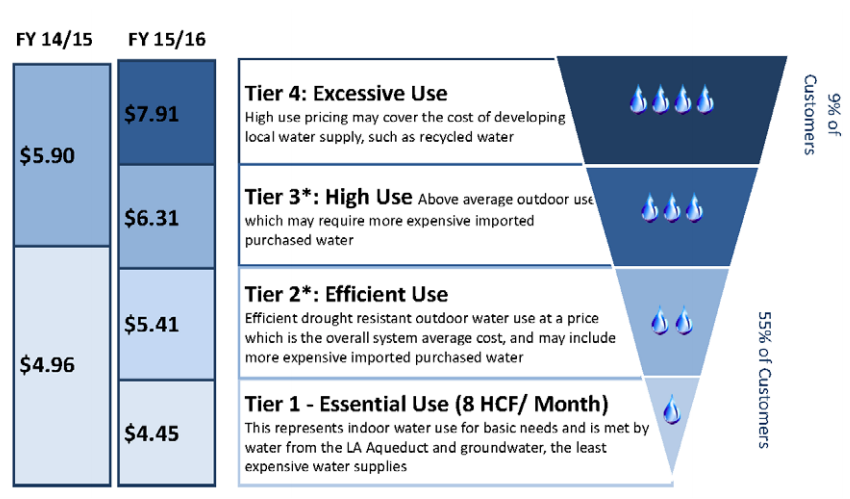
The impact of water rate increases proposed by the Los Angeles Department of Water and Power is likely to be heavy on West Hollywood apartment owners.
A survey by the Apartment Association of Greater Los Angeles (AAGLA) reveals that more than 86 percent of rental property owners in greater Los Angeles who pay for tenants’ water have seen usage increase or stay the same since Gov. Jerry Brown first mandated statewide restrictions in April. In West Hollywood, 78 percent of housing units are occupied by renters rather than owners. Apartment buildings typically have “master meters,” which means water usage is calculated and filled for an entire building rather than an individual apartment unit.
“The truth is, a shockingly small number of tenants seem compelled to do their part to help the state thought this difficult time,” said Jim Clarke, AAGLA executive vice president. “State and local leaders should be very concerned that the state’s largest water district will fall short of mandated reductions.”
The governor has mandated a 25 percent statewide reduction in water usage by February 2016. That number goes up or down based on a particular community’s current water usage. The Los Angeles Department of Water and Power, which serves 70 percent of West Hollywood residents, is planning to implement early next year its first rate increase since 2008. If approved by the LADWP board and the L.A. City Council, the increase will also include a change from a two-tier billing structure to a four-tier billing structure for individual homes. Apartment buildings would still have a two-tiered billing structure. Under its current timeline, LADWP expects the first rate hike will go into effect during the first quarter of 2016. Incremental adjustments would be made on July 1, 2016, July 1, 2017, July 1, 2018 and July 1, 2019. Other WeHo residents get their water from the City of Beverly Hills, which is implementing its own water conservation measures.
According to the AAGLA, most multifamily dwellings serviced by the LADWP are “master-metered,” not “sub-metered,” which means there aren’t meters measuring and billing for the use of water on individual apartments. Thus the building owners are responsible for the water used by the tenants in their buildings.
AAGLA’s survey of building owners found that about 90 percent own buildings that are master-metered, with only about eight percent reporting owning sub-metered buildings (two percent of those contacted for the survey did not respond). Among rental property owners with master-metered buildings, the following tenant water usage was reported since April:
- 14.4 percent increased water usage
- 72.2 percent were relatively unchanged
- Only 12.2 percent reduced water usage
“Not only can the LADWP and other water districts begin levying fines and fees against these property owners, rent control and other city housing regulations prevent rent increases or the installation of sub-meters for current tenants,” Clarke added. “There is simply no way to enforce usage restrictions on a majority of the city’s population.”

The water bandwagon is getting tiresome. Want some statistics that are NOT motivated by politicians covering their A$$??? Try here: http://www.ppic.org/main/publication_show.asp?i=1108 and here: http://www.ppic.org/main/publication_show.asp?i=1087 Urban areas use only 10% of the water supply in California. (OF THAT 10%, 1/2 is used for indoor and outdoor residential.) IN OTHER WORDS: If we (the people) were to cut out ALL showers -period- and sank into the middle ages …it only means 2.5% or less of the water supply saved. This shower chasing is a Straw-man. For what we may ask??? Because three years ago, the policy makers created the drought of today… Read more »
WeHo Mikey is correct (though the old washers don’t use quite THAT much–actually about 40-45 gallons total between wash and rinse phases. The high-efficiency ones use about a third of that). I penciled out that, at 24 residents doing 2 loads per person per week and 4.3 weeks per month, our building could save about 6,000 gallons per month–a pretty significant amount!
Building owners can install modern laundry equipment. Old-style washers use 50-60 gallons per wash load, while the newest Energy Star equipment uses 6-8 gallons. Multiply that by a handful of loads of laundry per week for each resident, and you can see a significant reduction in water use.
if you don’t cut back on your water use, you’re a racist republican and a mean person.
someone had to say it !
I am happy to say that the manager of our building has noted a decrease in our collective water use. I think the people in my building are taking this seriously. It’s hard to gage how to save, but little things shower heads, leaky faucet repairs and other things can help if you live in an apartment building.
I think it is ridiculous they are raising rates, when there are water pipes breaking underground almost weekly causing the loss of thousands of gallons of water each time. It the DWP had been replacing these old pipes, we wouldn’t have lost all that water. Where is their conservation? Why does the watering of lawns still go on downtown around gov’t buildings? I don’t shower every day anymore as my part, but in the building next door, there is a guy who bucket washed 3 of his 4or 5 cars last weekend. There will always be those who don’t over… Read more »
We’re all in this together. Time for the proverbial “honor system” to start governing our individual and collective use. Let the fines and increases fall where they may.
In my apartment building there are tenants that have endless overnight guests that stay not for one night or a weekend but weeks on end. So I’m sure they are all taking showers everyday.